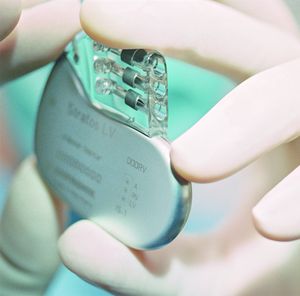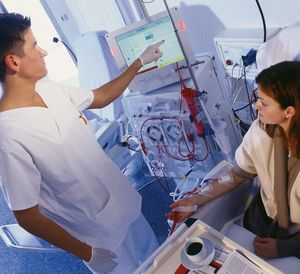KANBrief 3/17


In the autumn of 2012, the European Commission launched a revision of the European legislative framework for medical and in-vitro diagnostic medical devices. In the spring of 2017, two new regulations in this area came into force that have resulted in certain changes and also necessitate amendments to national legislation.
Medical devices are instruments, apparatus, appliances, materials and preparations intended for use for medical purposes such as for the diagnosis, prevention, monitoring, treatment or alleviation of disease. In contrast to pharmaceuticals, their primary effect in or upon the human body is attained not by pharmacological, immunological or metabolic means, but primarily by physical means. Active medical devices employ a source of energy such as electric power or compressed air.
Examples of medical devices are technical medical equipment (including the requisite software) such as x-ray machines, catheters, cardiac pacemakers, and also implants, medical instruments, products for injection, infusion, transfusion and dialysis, dental products, dressings, optical aids, contraceptive products, and in-vitro diagnostic products. The latter include reagents, reagent products, sample vessels, equipment, and further products used for the in-vitro analysis of samples from the human body.
Medicines and products such as in-vivo diagnostic products (e.g. contrast agents), cosmetics, personal protective equipment and products intended for use solely in veterinary medicine do not fall within the scope of the medical devices legislation.
German Medical Devices Act
The statutory instrument governing medical devices in Germany is the Medical Devices Act (MPG) (in german), which has been in force since 1 January 1995 and was last amended in 2013. The EU directives still applicable concerning active implantable medical devices (90/385/EEC (in german)), medical devices (93/42/EEC) and in-vitro diagnostic medical devices (98/79/EC) have been transposed by means of the MPG and the Medical Devices Ordinance (MPV) pursuant to it into German law.
The MPG serves to regulate the market for medical devices and to ensure their safety, suitability and performance and the safety and health of patients and users. In particular, it governs the requirements to be met for placing on the market and putting into service. Besides transposing European law, the MPG contains a series of national provisions, for example concerning the monitoring, operation and use of medical devices.
Duties of operators concerning implants
Erection, operation, use and maintenance of medical devices is governed in detail in Germany by the Medical Devices Operator Ordinance (MPBetreibV (in german)). In order to enhance patient safety, requirements of the MPBetreibV concerning institutions implanting medical devices were increased in 2014:
Requirements for market access
In order for medical devices to be placed on the Single Market and operated within it, they must bear a CE mark. The CE mark may be applied only if the product satisfies the essential safety and performance requirements set out in the relevant EU directives, the purpose of which is to protect patients and users alike during use of the products. The medical device must first undergo a procedure for minimization of risks, a clinical assessment, and a risk-benefit analysis. The specific requirements concerning the manufacture, performance and safe design of the medical devices are set out in the corresponding harmonized European standards. The standards are listed in the Official Journal of the EU (List of harmonized Standards) and give rise to a presumption of conformity with the requirements of the directive that they support.
The European Medical Devices Directive contains rules by which the products are assigned to three risk classes. Depending upon the risk class of the product, performance of the conformity assessment procedure may require the involvement of an independent test and certification body (notified body) that is subject to a state notification process and is monitored by the responsible authority. Only in the lowest risk class (I) may the manufacturer perform the procedure on his own account.
Medical devices bearing the CE mark may be placed on the market throughout the European Economic Area. However, they are subject to surveillance by the authorities of the Member States and to an observation and reporting system for the detection and avoidance of risks that become apparent retrospectively (vigilance system). In Germany, the Federal Institute for Drugs and Medical Devices (BfArM), the Paul Ehrlich Institute and the regional authorities form part of this system. Manufacturers must also be able to demonstrate, with reference to clinical data, the performance and the acceptability of the risk-benefit ratio of their products, as well as their technical safety.
New European statutory framework for medical devices and in vitro diagnostic devices
The new Medical Devices Regulation (EU) 2017/745 and Regulation (EU) 2017/746 on In Vitro Diagnostic Devices (IVDR) entered into force on 25 May 2017. In the future they will replace the current directives governing medical devices, which date back to the 1990s. Application of the Medical Devices Regulation becomes mandatory on 26 May 2020 and of the IVDR on 26 May 2022. EU regulations always apply directly and take priority over other legislation; they do not therefore need to be transposed into national law.
Areas for which the Medical Devices Regulation contains new requirements include the following:
Extensive action is now required at national level: contradictions and national legislation identical to the EU regulations must be eliminated, and considerable amendments must be made to the MPG for this purpose. The regulation also contains numerous requirements for the Member States to enact new legislation, for example concerning the involvement of ethics commissions in the authorization procedures for clinical tests. Problems relating to application of the Medical Devices Regulation and IVDR are currently being identified in the national working group for implementation of the Medical Devices Directive/IVDR, where they are to be resolved if at all possible.
Transitional periods
The EU regulation officially came into force on 25 May 2017. Its application becomes mandatory on 26 May 2020, at the end of a three-year transition period. Within this period, manufacturers may choose to be certified either under the existing legislation or, subject to certain conditions, under the new legislation.
Cornelia Hippchen
German Federal Ministry of Health Coordination of standardization